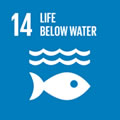Por favor, use este identificador para citar o enlazar a este item:
http://hdl.handle.net/10261/296114COMPARTIR / EXPORTAR:
 SHARE SHARE
 CORE
BASE CORE
BASE
|
|
| Visualizar otros formatos: MARC | Dublin Core | RDF | ORE | MODS | METS | DIDL | DATACITE | |

| Título: | Understanding the role of ecological factors affecting mercury concentrations in the blue shark (Prionace glauca) |
Autor: | Riesgo, Lola; Sanpera, Carolina; García-Barcelona, Salvador; Coll, Marta CSIC ORCID ; Navarro, Joan CSIC ORCID | Palabras clave: | Atlantic Ocean Mediterranean ocean Bio-indicator Blue shark Top predator Mercury Sharks Stable isotope |
Fecha de publicación: | feb-2023 | Editor: | Elsevier | Citación: | Chemosphere 313: 137642 (2023) | Resumen: | Human activities have increased environmental concentrations of pollutants in marine ecosystems, which can cause harmful effects on marine organisms. Top predators are particularly susceptible to bioaccumulation and biomagnification of pollutants through the food webs and are described as good sentinels for monitoring metal accumulation such mercury (Hg) in marine ecosystems. However, to be used as sentinels, it is important to understand the main ecological factors affecting the concentrations of pollutants in these organisms. In the present study, our main objective was to investigate the effect of body size, sex, trophic niche and geographic area on Hg concentrations in a top marine top predator, the blue shark (Prionace glauca). We analysed Hg in muscle samples from male and female blue sharks of different body sizes collected from the waters surrounding the Canary Islands and the South of Portugal, in the Atlantic Ocean, to waters of the north-western Mediterranean Sea. The results revealed that the sampling area was an important factor explaining Hg concentrations, showing higher values in the Mediterranean blue sharks. We also found a positive relationship between Hg concentrations and body size of blue sharks, indicating a bioaccumulation process of this pollutant in relation with body size. Moreover, we observed a relationship between Hg concentrations and δ13C values, a proxy of the use of inshore-offshore marine habitats. Individuals with depleted δ13C values that potentially foraged in offshore waters showed higher Hg values. Importantly, most of the analysed blue sharks presented Hg concentrations that exceeded the limits established by the European Union for human consumption | Descripción: | 8 pages, 4 figures, 4 tables, supplementary data https://doi.org/10.1016/j.chemosphere.2022.137642.-- Data availability: Data will be made available on request | Versión del editor: | https://doi.org/10.1016/j.chemosphere.2022.137642 | URI: | http://hdl.handle.net/10261/296114 | DOI: | 10.1016/j.chemosphere.2022.137642 | ISSN: | 0045-6535 |
| Aparece en las colecciones: | (ICM) Artículos (IEO) Artículos |
Ficheros en este ítem:
| Fichero | Descripción | Tamaño | Formato | |
|---|---|---|---|---|
| Riesgo_et_al_2023.pdf | 2,38 MB | Adobe PDF |  Visualizar/Abrir | |
| Riesgo_et_al_2023.docx | 25,62 kB | Microsoft Word XML | Visualizar/Abrir |
CORE Recommender
SCOPUSTM
Citations
4
checked on 24-abr-2024
WEB OF SCIENCETM
Citations
3
checked on 25-feb-2024
Page view(s)
48
checked on 02-may-2024
Download(s)
46
checked on 02-may-2024
Google ScholarTM
Check
Altmetric
Altmetric
Este item está licenciado bajo una Licencia Creative Commons



